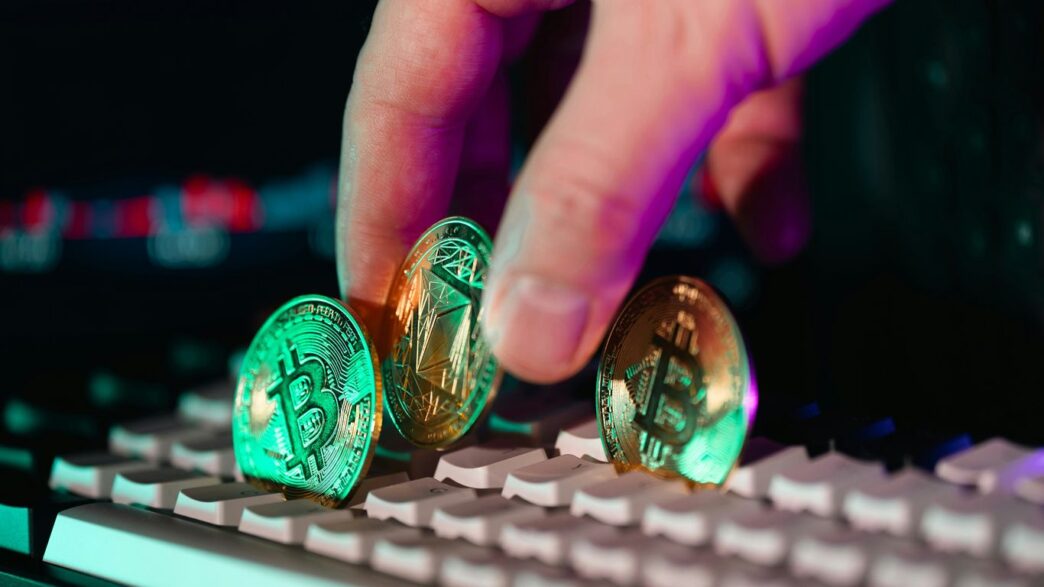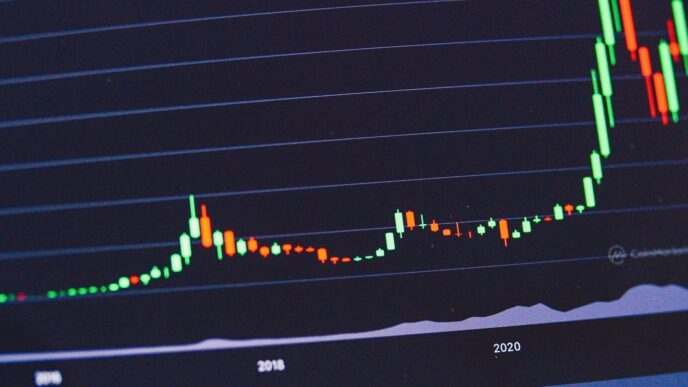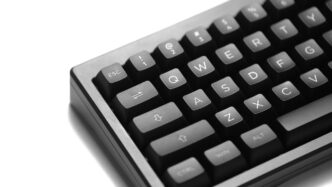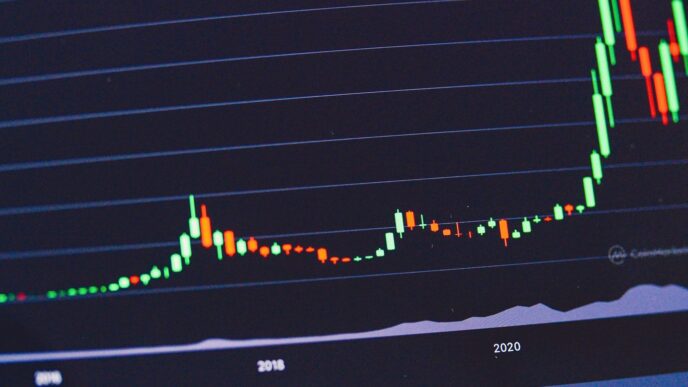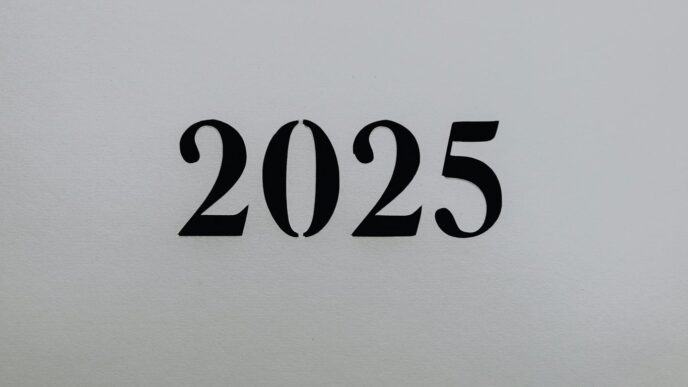Thinking about mining Bitcoin in 2025? It used to be something you could do from your computer at home, almost like a hobby. But things have changed a lot. The Bitcoin network has gotten bigger and more complex, and now it’s mostly big companies with special machines doing the mining. So, can your home PC still cut it? Let’s break down what you need to know about how to mine bitcoins with pc and if it’s even possible anymore.
Key Takeaways
- Bitcoin mining has moved from a home hobby to a specialized industry dominated by large operations with powerful ASIC miners.
- While technically possible to mine with a PC, it’s no longer profitable due to high network difficulty and electricity costs.
- ASIC miners are now required for any chance at profitability, costing thousands of dollars and consuming significant power.
- Joining a mining pool is almost always necessary for home miners to see any consistent rewards, sharing profits with others.
- Factors like electricity cost, hardware efficiency, and the current Bitcoin price heavily influence any potential for profit.
Assessing Bitcoin Mining Profitability in 2025

So, can you actually make money mining Bitcoin with your home setup in 2025? The short answer is: it’s complicated, and for most people, probably not in a way that replaces a regular paycheck. Let’s break down what’s really going on.
Understanding Bitcoin Halving Impacts
Every four years or so, something called a "halving" happens with Bitcoin. Basically, the reward miners get for successfully adding a new block of transactions to the blockchain gets cut in half. The most recent halving occurred in 2024, which means miners now receive 3.125 BTC per block, down from 6.25 BTC. This directly impacts how much new Bitcoin enters circulation and, consequently, how much revenue miners earn from their efforts. This reduction in block rewards is a major factor in why profitability has become so much harder for the average person.
The Role of Bitcoin’s Price
Bitcoin’s price is a huge piece of the puzzle. When the price is high, even with lower block rewards, the value of the Bitcoin you mine goes up, potentially making mining profitable. Conversely, if the price drops, mining becomes less attractive, even if you’re mining the same amount of Bitcoin. We’ve seen Bitcoin’s price swing wildly, and in 2025, its stability (or lack thereof) plays a massive role in whether your mining operation can cover its costs.
Evaluating Hash Rate and Network Difficulty
Think of the "hash rate" as the total computing power all miners are using to secure the network. The "network difficulty" is an automatic adjustment that makes it harder or easier to find a new block. As more powerful mining hardware comes online and more people try to mine, the hash rate goes up, and the network difficulty increases. This means your individual mining rig has to work harder and solve more complex problems to earn the same amount of Bitcoin. It’s a constant arms race; as hardware gets better, the difficulty goes up, making it tougher for older or less efficient machines to keep up.
Here’s a simplified look at how these factors interact:
| Factor | Impact on Profitability |
|---|---|
| Bitcoin Price | Higher price = potentially higher profit |
| Block Reward | Lower reward (post-halving) = lower profit |
| Network Difficulty | Higher difficulty = harder to earn rewards, lower profit |
| Hash Rate | Higher network hash rate = more competition, lower profit |
| Electricity Cost | Lower cost = higher profit |
| Hardware Efficiency | More efficient hardware = lower operating cost, higher profit |
Essential Hardware for Bitcoin Mining

Okay, so you’re thinking about mining Bitcoin in 2025. Forget about using that old laptop your uncle gave you. Those days are long gone. Mining Bitcoin today is a serious business, and it needs serious hardware.
The Necessity of ASIC Miners
If you want to have any chance of making a profit, you absolutely need an Application-Specific Integrated Circuit (ASIC) miner. These aren’t your everyday computers. ASICs are built for one thing and one thing only: mining Bitcoin using the SHA-256 algorithm. They’re super efficient at it, way more than any regular CPU or GPU could ever be. Think of them as specialized tools designed for a single, tough job. Companies like Bitmain (with their Antminer series), MicroBT (Whatsminer), and Canaan (AvalonMiner) are the big players here. You’ll find models that offer a lot of processing power, measured in terahashes per second (TH/s), and their efficiency is usually rated in joules per terahash (J/TH). The latest and greatest can set you back a pretty penny, often ranging from $2,000 to over $17,000.
Understanding Hash Rate and Efficiency
When you’re looking at ASIC miners, two numbers really matter: hash rate and efficiency. The hash rate tells you how much computing power the machine has – basically, how many guesses it can make per second to find a new block. More hashes mean more chances to earn Bitcoin. Efficiency, usually measured in J/TH, tells you how much electricity the miner uses to produce those hashes. Lower J/TH is always better because it means lower electricity costs, which is a huge deal for profitability.
Here’s a quick look at what you might see:
| Miner Model (Example) | Hash Rate (TH/s) | Power Consumption (Watts) | Efficiency (J/TH) |
|---|---|---|---|
| Antminer S21 Pro | 234 | ~3500 | ~15 |
| Whatsminer M66S | 298 | ~4000 | ~13.5 |
Keep in mind these are just examples, and the market changes fast. You’ll also need a robust Power Supply Unit (PSU) that can handle the miner’s power draw, often needing at least 20% more wattage than the miner’s continuous use. These PSUs can add another $50 to $300 to your setup cost.
Considering Hardware Longevity and Cost
Buying an ASIC is a big investment, so you need to think about how long it’ll last and if it’s worth the money. The initial cost of the hardware is just the start. You also have to factor in the electricity it uses, potential repair costs, and how quickly its performance might become outdated as newer, more powerful machines come out. A miner that seems cheap upfront might end up costing you more in the long run if it breaks down quickly or uses a lot of power compared to newer models. You want hardware that’s built well and can keep mining profitably for a good few years. It’s a balancing act between the upfront price, its energy use, and how long you expect it to remain competitive in the ever-changing Bitcoin mining landscape.
How to Mine Bitcoins With Your PC
Back in the day, you could probably mine Bitcoin with your regular computer. It was a simpler time, and the network wasn’t as crowded. But let’s be real, those days are long gone. The landscape of Bitcoin mining has changed dramatically. Trying to mine Bitcoin with a standard PC in 2025 is like trying to win the lottery with a single ticket – technically possible, but highly improbable to be profitable.
The Shift from Home Computers to Specialized Hardware
Think of it this way: Bitcoin mining is essentially a competition to solve complex math problems. The more computing power you have, the faster you can solve these problems and the higher your chances of earning a Bitcoin reward. As Bitcoin gained popularity, more people started mining, and the network automatically increased the difficulty of these problems to keep block creation times consistent. This meant that regular CPUs and even GPUs just couldn’t keep up anymore. The game changed, and specialized hardware, known as ASICs (Application-Specific Integrated Circuits), took over. These machines are built from the ground up for one purpose: mining Bitcoin as efficiently as possible. They are incredibly powerful and consume a lot of electricity, making them the only viable option for serious miners today. Trying to compete with an ASIC using your home computer is just not feasible.
Optimizing Your Mining Setup
If you’re still set on exploring home mining, even with the understanding that profitability is a long shot, there are a few things to consider. First, you’ll need to get your hands on an ASIC miner. These aren’t cheap, and they generate a significant amount of heat and noise, so you’ll need a dedicated space for them. Proper ventilation is a must to prevent overheating, which can damage your expensive equipment. You’ll also need a robust power supply to handle the energy demands. Beyond the hardware, you’ll need to configure your mining software. This involves setting up your wallet address to receive any potential rewards and connecting to a mining pool. The software allows you to monitor your miner’s performance, hash rate, and temperature. It’s all about maximizing efficiency and uptime, even if the odds are stacked against you. You can find various mining software options online, each with its own set of features and configurations.
The Importance of Stable Internet Connectivity
While mining doesn’t require super-fast internet speeds, it absolutely demands a stable and reliable connection. Think of it like this: your miner is constantly communicating with the Bitcoin network and the mining pool you’re connected to. If your internet connection drops, even for a few minutes, you stop mining and can miss out on potential rewards. This is why a wired Ethernet connection is almost always recommended over Wi-Fi. Ethernet is generally more stable and less prone to interference. You want to minimize any potential downtime, as every second your miner is offline is a lost opportunity. A consistent connection is key to ensuring your mining efforts aren’t in vain, even when using specialized hardware. For more on how mining works, you can check out how Bitcoin mining works.
Operational Costs and Profitability Factors
So, you’re thinking about mining Bitcoin from home in 2025. That’s cool, but before you get too excited, let’s talk about what it actually costs and what you can realistically expect to make. It’s not just about buying a fancy machine and plugging it in.
Electricity Consumption and Cost Management
This is probably the biggest one. Bitcoin mining rigs, especially the specialized ASIC miners, are power-hungry beasts. They run 24/7, crunching numbers, and that electricity bill can add up faster than you think. If you’re not getting electricity at a really good rate, like $0.05 per kilowatt-hour or less, it’s going to be tough to turn a profit. Seriously, look into your local rates. Sometimes, people set up operations in places with cheaper power, but for most of us at home, this is a major hurdle. You’ve got to balance the power your miner uses against how much Bitcoin it’s actually earning.
The Impact of Equipment Costs
We’ve touched on hardware before, but let’s be clear: these machines aren’t cheap. We’re talking thousands of dollars for a decent ASIC miner, plus power supplies, cooling systems to stop them from melting, and maybe even soundproofing because they’re loud. Then there’s the internet connection, which needs to be stable. All this initial investment needs to be paid back by your mining rewards. You also need to think about how long the hardware will last. Will it still be efficient enough in a year or two, or will you need to upgrade again? It’s a constant cycle of investment and hoping the Bitcoin price stays high enough to cover it all.
Calculating Potential Returns
Okay, so you’ve got your hardware, you’ve figured out your electricity cost. Now, how do you actually figure out if you’ll make money? It’s a bit of a puzzle.
- Hash Rate: This is how fast your miner can do calculations. More hash rate generally means more potential to earn Bitcoin.
- Network Difficulty: This is how hard it is to find a Bitcoin block. As more miners join, the difficulty goes up, making it harder for everyone.
- Bitcoin Price: Obviously, the higher the price of Bitcoin, the more your mined coins are worth in dollars.
- Pool Fees: If you join a mining pool (which you probably will), they take a small cut of your earnings for managing the process.
- Transaction Fees: Sometimes, you also get a share of the fees people pay to send Bitcoin transactions. This can add a little extra, especially when the network is busy.
Putting it all together, you can use online calculators to get an estimate. Just remember, these are just estimates. The market changes, difficulty changes, and your actual results could be different. It’s a good idea to be conservative with your projections.
Mining Strategies for Home Users
So, you’re thinking about mining Bitcoin from your own place in 2025? It’s definitely not like it was back in the early days when your laptop could do the job. The network’s gotten way more complex, and the competition is fierce. But that doesn’t mean it’s impossible to get involved. It’s more about being smart with your approach and understanding what’s realistic.
Solo Mining vs. Pool Mining
When you’re mining solo, you’re basically trying to solve those complex Bitcoin puzzles all by yourself. If you happen to find a block, you get the whole reward. Sounds great, right? The catch is, the odds of a home setup finding a block on its own are incredibly slim these days. It’s like buying a lottery ticket and expecting to win every week. You might get lucky, but don’t count on it.
Pool mining, on the other hand, is where you team up with a bunch of other miners. You all combine your computing power, and when the pool finds a block, the reward is split among everyone based on how much work they contributed. This means more consistent, smaller payouts rather than a rare, big win. For most home miners, joining a mining pool is the most practical way to see any kind of regular return.
Leveraging Mining Pools Effectively
Choosing the right mining pool is pretty important. You’ll want to look at a few things:
- Pool Fees: Most pools take a small percentage of your earnings. Compare these fees to find a good balance between cost and service.
- Payout Thresholds: This is the minimum amount of Bitcoin you need to earn before the pool sends it to your wallet. Lower thresholds mean you get your rewards more often.
- Server Location and Stability: A pool with servers closer to you can mean a more stable connection, which is good for your mining efficiency.
- Reputation: Do some digging. Look for reviews and see how long the pool has been around. You don’t want to put your effort into a pool that might disappear overnight.
Understanding Mining Software and Codes
Once you’ve picked a pool, you’ll need software to connect your mining hardware to it. This software acts as the go-between, telling your miner what to do and sending your results back to the pool. There are several popular mining software options out there, and they usually support a wide range of hardware. You’ll typically need to configure the software with your pool’s address and your unique miner ID (which is often linked to your Bitcoin wallet address). While you don’t need to be a coding wizard, understanding the basic settings can help you optimize your setup. Some advanced users might tweak certain parameters for better performance, but for most, sticking to the default settings provided by the pool and software is a safe bet.
Risks and Alternatives in Bitcoin Mining
So, you’re thinking about mining Bitcoin from your home setup in 2025? It’s definitely not as simple as it used to be, and there are some pretty big hurdles to jump over. Let’s talk about the downsides and what else you can do if home mining just isn’t cutting it.
Navigating Market Volatility and Regulatory Hurdles
First off, the price of Bitcoin itself is a wild ride. One day it’s up, the next it’s down. This makes predicting your profits really tricky. If the price tanks, your earnings can disappear just as fast. Plus, governments around the world are still figuring out how they feel about crypto. Regulations can change, and what’s allowed today might not be tomorrow. This uncertainty can make investing in mining equipment feel like a gamble. It’s a good idea to keep an eye on how Bitcoin is viewed as a store of value, similar to gold [d905].
Addressing Environmental and Operational Concerns
Mining uses a ton of electricity. Seriously, a lot. This is a big deal for the environment, and it also means your electricity bill is going to be sky-high. Beyond that, those mining machines get loud and hot. If you’re thinking of running them in your house, get ready for some serious noise and heat. It’s not exactly comfortable, and it can wear out your gear faster.
Exploring Cloud and Hosted Mining Options
If all this sounds like too much, don’t worry, there are other ways to get involved without turning your home into a noisy, hot server room:
- Cloud Mining: This is where you rent computing power from a company. You pay them, and they do all the mining for you. It sounds easy, but you have to trust the company completely. Sadly, a lot of cloud mining operations are scams, and even the legit ones often take a big cut of your profits through fees. You also don’t have much control.
- Hosted Mining: With this option, you buy your own mining hardware, but you pay a specialized company to store it and run it for you. It’s a middle ground. You own the gear, but someone else handles the electricity, cooling, and maintenance. This can be more profitable than cloud mining because these facilities get better electricity rates, but it still requires a big upfront cost for the hardware and ongoing fees.
For most people, trying to mine Bitcoin profitably with a standard PC in 2025 is just not realistic. The specialized hardware, electricity costs, and network difficulty make it incredibly tough. It’s more of a hobby or a learning experience than a way to make serious money these days.
So, Can You Still Mine Bitcoin With Your PC in 2025?
Alright, let’s wrap this up. The short answer to whether you can mine Bitcoin with your home PC in 2025 is… well, it’s complicated. Gone are the days when a regular computer could earn you a decent chunk of Bitcoin. The mining game has gotten super professional, with big companies and specialized machines called ASICs doing most of the heavy lifting. For the average person, trying to mine Bitcoin at home with just a PC is pretty much a losing game due to the insane electricity costs and the sheer difficulty of the puzzles. You’d likely spend more on power than you’d ever earn back. While home mining still plays a small part in keeping Bitcoin decentralized, making a profit from your living room is highly unlikely these days. If you’re really set on mining, you’d need to look into serious investment in ASIC hardware and finding access to very cheap electricity, which most of us just don’t have readily available. For most people, just buying Bitcoin directly is a much more sensible approach.
Frequently Asked Questions
Can I really mine Bitcoin with my regular computer anymore?
In the past, you could mine Bitcoin with a regular computer, but not anymore. The process has become super competitive, needing special, powerful machines called ASIC miners. Think of it like trying to win a race with a bicycle when everyone else has a super-fast race car. Your regular computer just can’t keep up.
What’s the biggest reason home mining isn’t as profitable now?
The main reason is that mining Bitcoin has gotten really hard. The network automatically makes it tougher as more people try to mine. Plus, the computers needed are super expensive and use a lot of electricity, which costs money. So, the cost to mine is often more than what you earn back.
How much does it cost to start mining Bitcoin today?
Getting started with serious Bitcoin mining today is pricey. You’ll need to buy specialized ASIC miners, which can cost anywhere from $2,000 to over $20,000. On top of that, you have to pay for electricity, which can add up quickly. It’s a big investment.
What is a ‘mining pool’ and why should I use one?
A mining pool is like a team for miners. Instead of trying to solve the hard Bitcoin puzzles all by yourself (which is almost impossible), you join forces with many other miners. When the pool finds a Bitcoin, everyone shares the reward based on how much computing power they contributed. It’s a much more reliable way to get small, regular payouts.
Is it still worth mining Bitcoin if I don’t make a lot of money?
Some people still mine Bitcoin at home not just for profit, but to help keep the Bitcoin network strong and spread out. It helps make sure no single group has too much control. However, for most people, the cost of electricity and equipment usually outweighs the small rewards you might get.
Are there easier ways to get involved with Bitcoin mining without buying hardware?
Yes, there are! One option is ‘cloud mining,’ where you rent computing power from a company that already has the mining machines. Another is ‘hosted mining,’ where you buy the hardware but have someone else manage it for you. These can be simpler, but you need to be careful and choose trusted providers to avoid scams.


